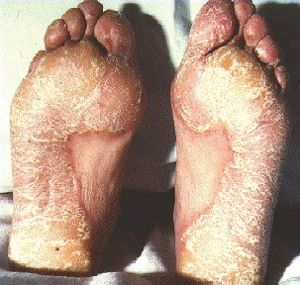Psoriasis: Difference between revisions
Kingrajinix (talk | contribs) |
Kingrajinix (talk | contribs) No edit summary |
||
| Line 22: | Line 22: | ||
*Auspitz sign - pin-point bleeding on scale removal | *Auspitz sign - pin-point bleeding on scale removal | ||
===Management=== | ===Management=== | ||
===Prognosis=== | ===Prognosis=== | ||
Revision as of 16:42, 8 December 2009
Definition
A scaly and inflammatory rash caused by hyperproliferation of keratinocytes.
Epidemiology
Affects both sexes pretty much equally and has a prevalence of around 2% in the UK population. There is a genetic element to the disease. It peaks at 15-20 and 55-60 and results in a seronegative arthropathy in about 7% patients.
Pathophysiology
The causes are multifactorial - genetic, infective in some cases (guttate), stress, trauma, drugs (alcohol, beta-blockers, NSAIDs, antimalarials, lithium).
THere are two mechanisms; the first is hyperproliferation of keratinocytes in response to cytokines. These form what are referred to as psoriatic plaques. The time it takes for epidermal cells to move through the epidermis (transit time) changes from 30 days to about 2-3 days. The epidermis becomes 3-5 times thicker than usual (acanthosis); and starts to form "rete" ridges (arrowheads). This layer thickens further forming the stratum corneum".
The second mechanism is inflammatory infiltration. There is more intracellular adhesion in the epidermis and it is infiltrated by neutrophils and lymphocytes. You can get (Munro's) microabscesses in the stratum corneum. Finally, you get dilated, tortuous capillaries in the outer dermal layer. When scales are removed it causes pin-point bleeding called Auspitz sign.
Clinical Features
Psoriatic plaques are red plaques with silvery scales. It can occur on extensor surfaces of elbows, knees, scalp and sacrum. Flexures are frequently affected - axillae, groin, submammary, umbilicus - though they are usually not scaly. Smaller plaques (guttae of guttate psoriasis) are often seen in children. Other signs:
- Nails - pitting, onycholysis (seperation from nailbed)
- Pustules variant - can appear on the hands and the feet in this variant of normal psoriasis
- Erythrodermic/generalised - can cause severed systemic illness (fever, raised WCC, dehydration). Can be due to steroid withdrawal.
- Koebner phenomenon - plaques follow lines of trauma
- Auspitz sign - pin-point bleeding on scale removal
